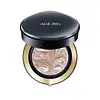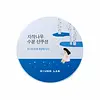Age20's Signature Essence Cover Pact SPF 50+ Versus Round Lab Birch Juice Moisturizing Sun Cushion SPF 50+ PA++++
What's inside
What's inside
 Key Ingredients
Key Ingredients

 Benefits
Benefits

 Concerns
Concerns

 Ingredients Side-by-side
Ingredients Side-by-side

Betula Platyphylla Japonica Juice
Skin ConditioningTitanium Dioxide
Cosmetic ColorantButyloctyl Salicylate
Skin ConditioningPolysilicone-15
UV FilterButylene Glycol Dicaprylate/Dicaprate
EmollientButylene Glycol
HumectantDiethylamino Hydroxybenzoyl Hexyl Benzoate
UV FilterOctocrylene
UV AbsorberPhenyl Trimethicone
Skin ConditioningDipropylene Glycol
HumectantNiacinamide
SmoothingEuphorbia Cerifera Wax
Cyclopentasiloxane
EmollientTriethylhexanoin
MaskingHydrogenated Poly(C6-14 Olefin)
EmollientPvp
Emulsion StabilisingTriisostearin
Skin ConditioningCyclohexasiloxane
EmollientPolymethylsilsesquioxane
Silica
AbrasivePolyglyceryl-4 Diisostearate/Polyhydroxystearate/Sebacate
EmulsifyingDimethicone
EmollientSodium Glutamate
MaskingVp/Hexadecene Copolymer
Aluminum Hydroxide
EmollientC30-45 Alkyl Methicone
EmollientP-Anisic Acid
MaskingStearic Acid
CleansingC30-45 Olefin
Skin ConditioningLauryl Dimethicone/Polyglycerin-3 Crosspolymer
CleansingGlyceryl Caprylate
EmollientPentylene Glycol
Skin ConditioningTriethoxycaprylylsilane
Caprylic/Capric Triglyceride
MaskingAlumina
AbrasivePolyglyceryl-3 Oleate
Emulsifying1,2-Hexanediol
Skin ConditioningCaprylyl Glycol
EmollientPanthenol
Skin ConditioningTocopheryl Acetate
AntioxidantDiisostearoyl Polyglyceryl-3 Dimer Dilinoleate
EmollientWater
Skin ConditioningStearyl Heptanoate
EmollientAdenosine
Skin ConditioningCeramide NP
Skin ConditioningMyristoyl/Palmitoyl Oxostearamide/Arachamide Mea
Skin ConditioningCholesterol
EmollientSodium Hyaluronate
HumectantHydrolyzed Hyaluronic Acid
HumectantLactic Acid
BufferingPCA
HumectantGlucose
HumectantGlycine
BufferingNelumbo Nucifera Leaf Extract
Skin ConditioningSodium Glycerophosphate
Urea
BufferingSerine
MaskingGlutamic Acid
HumectantPotassium Magnesium Aspartate
BufferingPolymethyl Methacrylate
Aspartic Acid
MaskingLeucine
Skin ConditioningSodium Chloride
MaskingAlanine
MaskingAvena Sativa Peptide
Skin ConditioningHydrolyzed Collagen
EmollientPolyglutamic Acid
Skin ConditioningLysine
Skin ConditioningArginine
MaskingCalcium Gluconate
HumectantMagnesium Gluconate
Skin ConditioningPhenylalanine
MaskingProline
Skin ConditioningThreonine
Tyrosine
MaskingValine
MaskingIsoleucine
Skin ConditioningCitric Acid
BufferingAcetyl Glucosamine
Skin ConditioningCreatine
Skin ConditioningCysteine
AntioxidantHistidine
HumectantUric Acid
BufferingMethionine
Skin ConditioningCI 77492
Cosmetic ColorantCI 77491
Cosmetic ColorantCI 77499
Cosmetic ColorantCI 77007
Cosmetic ColorantBetula Platyphylla Japonica Juice, Titanium Dioxide, Butyloctyl Salicylate, Polysilicone-15, Butylene Glycol Dicaprylate/Dicaprate, Butylene Glycol, Diethylamino Hydroxybenzoyl Hexyl Benzoate, Octocrylene, Phenyl Trimethicone, Dipropylene Glycol, Niacinamide, Euphorbia Cerifera Wax, Cyclopentasiloxane, Triethylhexanoin, Hydrogenated Poly(C6-14 Olefin), Pvp, Triisostearin, Cyclohexasiloxane, Polymethylsilsesquioxane, Silica, Polyglyceryl-4 Diisostearate/Polyhydroxystearate/Sebacate, Dimethicone, Sodium Glutamate, Vp/Hexadecene Copolymer, Aluminum Hydroxide, C30-45 Alkyl Methicone, P-Anisic Acid, Stearic Acid, C30-45 Olefin, Lauryl Dimethicone/Polyglycerin-3 Crosspolymer, Glyceryl Caprylate, Pentylene Glycol, Triethoxycaprylylsilane, Caprylic/Capric Triglyceride, Alumina, Polyglyceryl-3 Oleate, 1,2-Hexanediol, Caprylyl Glycol, Panthenol, Tocopheryl Acetate, Diisostearoyl Polyglyceryl-3 Dimer Dilinoleate, Water, Stearyl Heptanoate, Adenosine, Ceramide NP, Myristoyl/Palmitoyl Oxostearamide/Arachamide Mea, Cholesterol, Sodium Hyaluronate, Hydrolyzed Hyaluronic Acid, Lactic Acid, PCA, Glucose, Glycine, Nelumbo Nucifera Leaf Extract, Sodium Glycerophosphate, Urea, Serine, Glutamic Acid, Potassium Magnesium Aspartate, Polymethyl Methacrylate, Aspartic Acid, Leucine, Sodium Chloride, Alanine, Avena Sativa Peptide, Hydrolyzed Collagen, Polyglutamic Acid, Lysine, Arginine, Calcium Gluconate, Magnesium Gluconate, Phenylalanine, Proline, Threonine, Tyrosine, Valine, Isoleucine, Citric Acid, Acetyl Glucosamine, Creatine, Cysteine, Histidine, Uric Acid, Methionine, CI 77492, CI 77491, CI 77499, CI 77007
Water
Skin ConditioningZinc Oxide
Cosmetic ColorantCaprylyl Methicone
Skin ConditioningMethyl Trimethicone
Skin ConditioningTitanium Dioxide
Cosmetic ColorantButylene Glycol Dicaprylate/Dicaprate
EmollientButyloctyl Salicylate
Skin ConditioningPolyglyceryl-4 Diisostearate/Polyhydroxystearate/Sebacate
EmulsifyingPropanediol
SolventGlycerin
HumectantMethyl Methacrylate Crosspolymer
Diisostearyl Malate
EmollientGlyceryl Glucoside
HumectantEthylhexylglycerin
Skin ConditioningLaminaria Japonica Extract
Skin ProtectingUlmus Davidiana Root Extract
Skin ConditioningAloe Barbadensis Leaf Extract
EmollientViola Mandshurica Flower Extract
AntioxidantDioscorea Japonica Root Extract
Skin ConditioningSodium Hyaluronate
HumectantHyaluronic Acid
HumectantDipotassium Glycyrrhizate
HumectantAllantoin
Skin ConditioningPortulaca Oleracea Extract
Skin ConditioningAdansonia Digitata Seed Extract
Skin ConditioningAscorbic Acid
AntioxidantButylene Glycol
HumectantDimer Dilinoleyl Dimer Dilinoleate
EmollientMagnesium Sulfate
Aluminum Hydroxide
EmollientDisteardimonium Hectorite
StabilisingStearic Acid
CleansingTriethoxycaprylylsilane
Polyglyceryl-6 Polyricinoleate
Emulsifying1,2-Hexanediol
Skin ConditioningDicaprylyl Carbonate
EmollientSorbitan Caprylate
EmulsifyingGlyceryl Caprylate
EmollientCaprylyl Glycol
EmollientTocopherol
AntioxidantWater, Zinc Oxide, Caprylyl Methicone, Methyl Trimethicone, Titanium Dioxide, Butylene Glycol Dicaprylate/Dicaprate, Butyloctyl Salicylate, Polyglyceryl-4 Diisostearate/Polyhydroxystearate/Sebacate, Propanediol, Glycerin, Methyl Methacrylate Crosspolymer, Diisostearyl Malate, Glyceryl Glucoside, Ethylhexylglycerin, Laminaria Japonica Extract, Ulmus Davidiana Root Extract, Aloe Barbadensis Leaf Extract, Viola Mandshurica Flower Extract, Dioscorea Japonica Root Extract, Sodium Hyaluronate, Hyaluronic Acid, Dipotassium Glycyrrhizate, Allantoin, Portulaca Oleracea Extract, Adansonia Digitata Seed Extract, Ascorbic Acid, Butylene Glycol, Dimer Dilinoleyl Dimer Dilinoleate, Magnesium Sulfate, Aluminum Hydroxide, Disteardimonium Hectorite, Stearic Acid, Triethoxycaprylylsilane, Polyglyceryl-6 Polyricinoleate, 1,2-Hexanediol, Dicaprylyl Carbonate, Sorbitan Caprylate, Glyceryl Caprylate, Caprylyl Glycol, Tocopherol
 Reviews
Reviews

Ingredients Explained
These ingredients are found in both products.
Ingredients higher up in an ingredient list are typically present in a larger amount.
1,2-Hexanediol is a synthetic liquid and another multi-functional powerhouse.
It is a:
- Humectant, drawing moisture into the skin
- Emollient, helping to soften skin
- Solvent, dispersing and stabilizing formulas
- Preservative booster, enhancing the antimicrobial activity of other preservatives
Aluminum Hydroxide is a form of aluminum. It can be naturally found in nature as the mineral gibbsite. In cosmetics, Aluminum Hydroxide is used as a colorant, pH adjuster, and absorbent.
As a colorant, Aluminum Hydroxide may add opacity, or reduce the transparency. Aluminum hydroxide is contains both basic and acidic properties.
According to manufacturers, this ingredient is an emollient and humectant. This means it helps hydrate the skin.
In medicine, this ingredient is used to help relieve heartburn and help heal ulcers.
There is currently no credible scientific evidence linking aluminum hydroxide in cosmetics to increased cancer risk.
Major health organizations allow the use of aluminum hydroxide in personal care products and have not flagged it as a carcinogenic risk at typical usage levels.
Learn more about Aluminum HydroxideButylene Glycol (or BG) is used within cosmetic products for a few different reasons:
Overall, Butylene Glycol is a safe and well-rounded ingredient that works well with other ingredients.
Though this ingredient works well with most skin types, some people with sensitive skin may experience a reaction such as allergic rashes, closed comedones, or itchiness.
Learn more about Butylene GlycolWe don't have a description for Butylene Glycol Dicaprylate/Dicaprate yet.
Butyloctyl Salicylate is a chemical UV filter structurally similar to octisalate. It is a photostabilizer, SPF booster, emollient and solvent. This ingredient helps evenly spread out ingredients.
According to a manufacturer, it is suitable for pairing with micro Titanium Dioxide, Zinc Oxide, and pigments.
Photostabilizers help stabilize UV-filters and prevents them from degrading quickly.
Learn more about Butyloctyl SalicylateCaprylyl Glycol is a humectant and emollient, meaning it attracts and preserves moisture.
It is a common ingredient in many products, especially those designed to hydrate skin. The primary benefits are retaining moisture, skin softening, and promoting a healthy skin barrier.
Though Caprylyl Glycol is an alcohol derived from fatty acids, it is not the kind that can dry out skin.
This ingredient is also used as a preservative to extend the life of products. It has slight antimicrobial properties.
Learn more about Caprylyl GlycolGlyceryl Caprylate comes from glycerin and caprylic acid, a fatty acid from coconut. It has emollient and emulsifier properties.
As an emollient, it helps hydrate your skin. Emollients work by creating a barrier on your skin to trap moisture in, helping to keep your skin soft and smooth.
On the other hand, emulsifiers prevent ingredients (such as oil and water) from separating.
Learn more about Glyceryl CaprylatePolyglyceryl-4 Diisostearate/Polyhydroxystearate/Sebacate isn't fungal acne safe.
Sodium Hyaluronate is hyaluronic acid's salt form. It is commonly derived from the sodium salt of hyaluronic acid.
Like hyaluronic acid, it is great at holding water and acts as a humectant. This makes it a great skin hydrating ingredient.
Sodium Hyaluronate is naturally occurring in our bodies and is mostly found in eye fluid and joints.
These are some other common types of Hyaluronic Acid:
Learn more about Sodium HyaluronateStearic Acid is a fatty acid. It is an emollient, emulsifier, and texture enhancer.
As an emollient, stearic acid helps soften skin. It aids the skin's protective barrier by preventing water loss. It also provides a gentle cleansing effect without stripping away natural oils.
Stearic acid may also be used to enhance the texture of products. It can add volume and stabilize ingredients such as water and oil. This can help water and oil ingredients from separating.
Sources of stearic acid include animal or vegetable fats/oils such as coconut or shea. It can be naturally found in butter, cocoa butter, shea butter, vegetable fats, and animal tallow.
This ingredient may not be Malassezia folliculitis, or fungal-acne safe.
Learn more about Stearic AcidTitanium dioxide is a mineral UV filter widely used in sunscreens and cosmetics.
It is one of only two UV filters officially classified as “mineral” by regulatory agencies, the other being zinc oxide.
Titanium dioxide provides broad-spectrum protection mostly in the UVB and UVAII range, with some protection in the UVAI range.
While its UVA protection isn’t as strong as zinc oxide’s, the difference is minor.
A common myth is that mineral UV filters reflect UV light. However, modern research shows titanium dioxide absorbs UV radiation like chemical filters (~95% absorption & 5% reflection).
Thanks to its non-irritating nature, titanium dioxide is suitable for sensitive, acne-prone, or redness-prone skin. It is unlikely to cause "eye sting" like other sunscreen ingredients.
A major drawback of this ingredient is its white cast and thick texture. This is why mineral sunscreens often leave a white cast and are less cosmetically elegant than chemical/hybrid sunscreens.
To improve white cast and spreadability, micronized or nano-sized titanium dioxide is often used.
There are ongoing concerns surrounding nano-titanium oxide's impact on marine ecosystems.
There is no conclusive evidence that any form of titanium oxide (or any other sunscreen ingredients) will cause harm to marine ecosystems or coral reefs. The science is still developing but many consumers are keeping a close eye on this issue.
Please note, many destinations have reef-safety sunscreen rules. For instance, the U.S. Virgin Islands advises all visitors to use non-nano mineral sunscreens.
Nano mineral sunscreens once raised safety concerns about absorption into skin.
Extensive research has shown that they do not penetrate healthy or damaged skin; they remain safely on the surface and the top layer of dead skin (stratum corneum).
You'll likely find titanium dioxide bundled with alumina, silica, or dimethicone. These ingredients help make titanium dioxide highly photostable; this prevents it from interacting with other formula components under UV light.
Learn more about Titanium DioxideTriethoxycaprylylsilane is a silicone used to bind and stabilize ingredients.
As an emulsifier, it helps prevent ingredients from separating. This can help elongate the shelf life of products.
Triethoxycaprylylsilane is often used to coat mineral sunscreens ingredients to help give a better feel. It also helps reduce oxidative stress in sunscreens.
Learn more about TriethoxycaprylylsilaneWater. It's the most common cosmetic ingredient of all. You'll usually see it at the top of ingredient lists, meaning that it makes up the largest part of the product.
So why is it so popular? Water most often acts as a solvent - this means that it helps dissolve other ingredients into the formulation.
You'll also recognize water as that liquid we all need to stay alive. If you see this, drink a glass of water. Stay hydrated!
Learn more about Water